2014

World No Tobacco Day, 31 May 2014 - Raise taxes on tobacco
For World No Tobacco Day 2014, WHO and partners call on countries to raise taxes on tobacco.
Under the WHO Framework Convention on Tobacco Control (WHO FCTC), countries should implement tax and price policies on tobacco products as a way to reduce tobacco consumption. Research shows that higher taxes are especially effective in reducing tobacco use among lower-income groups and in preventing young people from starting to smoke. A tax increase that increases tobacco prices by 10% decreases tobacco consumption by about 4% in high-income countries and by up to 8% in most low- and middle-income countries.
Furthermore, increasing excise taxes on tobacco is considered to be the most cost-effective tobacco control measure. The World Health Report 2010 indicated that a 50% increase in tobacco excise taxes would generate a little more than US$ 1.4 billion in additional funds in 22 low-income countries. If allocated to health, government health spending in these countries could increase by up to 50%.
Goals
The ultimate goal of World No Tobacco Day is to contribute to protecting present and future generations not only from the devastating health consequences due to tobacco, but also from the social, environmental and economic scourges of tobacco use and exposure to tobacco smoke.
Specific goals of the 2014 campaign are that:
- governments increase taxes on tobacco to levels that reduce tobacco consumption;
- individuals and civil society organizations encourage their governments to increase taxes on tobacco to levels that reduce consumption.
Every year, on 31 May, WHO and partners everywhere mark World No Tobacco Day, highlighting the health risks associated with tobacco use and advocating for effective policies to reduce tobacco consumption. Tobacco use is the single most preventable cause of death globally and is currently responsible for 10% of adult deaths worldwide.
Related links
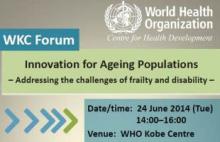
WKC Forum: Innovation for Ageing Populations – Addressing the challenges of frailty and disability
The WHO Kobe Centre (WKC) will organize an open forum on “Innovation for Ageing Populations – Addressing the challenges of frailty and disability –” in Kobe on 24 June 2014.
By 2020, the world population is projected to reach 7.7 billion. Out of this, those 65 years old and above will reach 1 billion, outnumbering the number of children less than 5 years of age which will only be 650 million. In short, the world’s demography is unprecedentedly changing. It is definitely and rapidly ageing.
At this WKC Forum, a WHO expert and three Japanese experts will present their respective framework, evidence-based body of work and strategic recommendations in moving forward on addressing current and emerging frailty and disability in ageing populations through innovations in assistive technology. With diverse backgrounds (i.e., disability; assistive technology; community-based rehabilitation; and prosthetics and orthotics education), they will engage the local community on a lively discussion, answering any question or clarification with regard to their topics of expertise, all towards advancing innovation for healthy ageing.
The forum will be organized in collaboration with the Hyogo Institute of Assistive Technology, Japan.
Date & venue:
24 June 2014 (Tuesday) 14:00 –16:00
WHO Kobe Centre
Programme:
Language: Japanese
14:00–14:10 Opening remarks
14:10–15:20 Presentations
15:20–15:55 Discussion
15:55–16:00 Closing remarks
Speakers:
(in order of presentations)
Mr Chapal Khasnabis
Technical Officer, Disability and Rehabilitation, Violence and Injury Prevention and Disability
World Health Organization (WHO)
Dr Takaaki Chin
President, International Society for Prosthetics and Orthotics (ISPO), Japan
Director, Hyogo Institute of Assistive Technology
Director, Robot Rehabilitation Center, Hyogo Rehabilitation Center
Dr Seishi Sawamura
Principal and Honorary Director, Hyogo Rehabilitation Center
Mr Toshifumi Komine
Prosthetics and Orthotics Course Director
Kumamoto College of Medical Care and Rehabilitation
For more details:
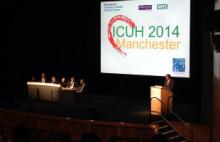
11th International Conference on Urban Health (ICUH), 4-7 March 2014, Manchester, the United Kingdom
“The city is at the center of the opportunity to contribute to better access to health and social services, and to create more livable environments for all of us,” said Dr. Marie-Paule Kieny, Assistant Director-General of the World Health Organization, at the plenary of the 11th International Conference on Urban Health (ICUH) in Manchester.
The 11th ICUH held 4-7 March 2014 was hosted by the University of Manchester and was attended by more than 1,000 participants. In his plenary speech, Alex Ross, Director of WHO Kobe Centre (WKC), emphasized the importance of achieving universal health coverage in cities and protecting people from financial risks due to health care costs.
WKC staff organized and presented at many events including three plenary sessions, a pre-conference workshop on Urban HEART, and six parallel sessions. The conference was a valuable opportunity to share and exchange information, as well as to build and strengthen networks.
Plenary Sessions
There were four plenary sessions that were addressed by WKC and WHO Geneva officials. This included speeches by WHO Assistant Director-General of Health Systems and Innovation, Dr. Marie-Paule Kieny, and Director of WHO Kobe Centre, Alex Ross.
Wednesday PM, 5th March
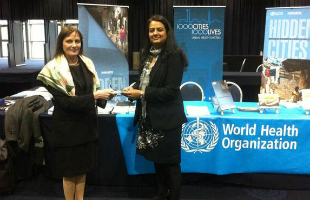
In her keynote address, Dr. Marie-Paule Kieny, Assistant Director-General of WHO, emphasized that increasingly, international and national policy makers are turning to municipal leaders to take action. She reiterated that WHO is committed to working with the urban health community in supporting measurement, collecting evidence and best practice, and jointly working in the quest for universal health coverage.
Dr. Kieny was awarded the Manchester Academic Health Science Centre (MAHSC) Health and Wellbeing Award for her work on vaccine research and leading WHO’s Initiative on Vaccine Research.
Thursday AM, 6th March
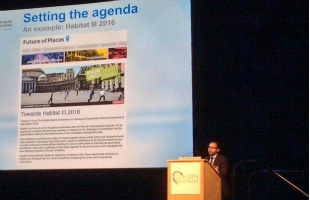
Thursday PM, 6th March
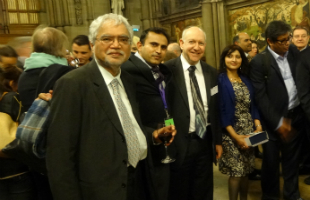
Friday PM, 7th March
In the closing plenary a debate titled “Urbanization: Love it or Hate it?” was organized between seven speakers including Amit Prasad (WHO Kobe Centre), Debbie Abrahams (Member of Parliament, England), Dr. Francoise Barten (PAHO), Prof. Jo Ivey Boufford (New York Academy of Medicine), Dr. Ana Diez Roux (Drexel University School of Public Health), Prof. Mukesh Kapila (University of Manchester), and Prof. Mala Rao (University of East London). Three speakers each supported and opposed the motion. The audience polled their opinions both before and after the debate.
Workshop
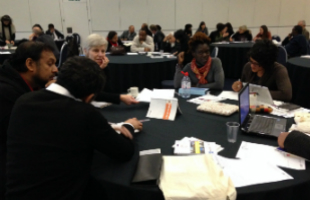
- Link to “Challenges of using Urban HEART in Barcelona”
- Link to “Urban HEART and the Toronto experience”
Parallel Sessions
Urban Health Metrics work stream
WKC co-organized this work stream with research collaborators from Georgia State University (GSU) School of Public Health (Atlanta, USA). The work stream included 4 technical sessions.
1. Geospatial analysis of urban health inequalities
Carme Borrell (Public Health Agency of Barcelona) and Dajun Dai (GSU) demonstrated the application of geospatial analysis, citing examples from the INEQ-CITIES project in Europe and from cities in the US, respectively.
- Link to "the experiences of MEDEA and INEQCITIES projects in creating City Atlas of Inequalities in Mortality"
- Link to "Urban GIS for health metrics"
2. European Urban Health Indicators Part Two (EURO-URHIS 2) - transporting to new places
Arpana Verma (University of Manchester) provided an overview of the European Urban Health Indicators Part Two (EURO-URHIS 2) project whose scientific committee included WKC. Richard Rothenberg (GSU), Dajun Dai (GSU) and Fu Hua (Fudan University) described efforts to transfer the methodology beyond Europe, giving the example of piloting in Shanghai, China.
3. Global Health Indicator Framework and Toolkit (GHIFT) Collaborative
This session introduced a new international research partnership, tentatively named the Global Health Indicator Framework and Toolkit (GHIFT) Collaborative, led by GSU and joined by the University of Manchester, Fudan University of China, and WKC. The various partners in the collaborative explained their expectations for and contributions to the group. Megumi Kano (WKC) presented the perspective of WKC.
- Link to “GHIFT perspectives from Shanghai, China”
- Link to “WHO Kobe Centre – advocate of urban health metrics development”
4. Urban Health Index
Richard Rothenberg (GSU), who led this project with the support of WKC, provided a full description of the newly developed Urban Health Index –how the Index is actually calculated, how its results can be displayed using spatial mapping techniques, and what value it can add to urban health research and policy-making. Concrete examples of its application in Rio de Janeiro (Brazil), Shanghai (China) and Tokyo (Japan) were presented by Martin Bortz (Medical School University of Heidelberg), Dajun Dai (GSU) and Scott Weaver (GSU), respectively. The session was moderated by Megumi Kano (WKC).
- Link to “An Urban Health Index”
- Link to ”Application of the Urban Health Index to studying geospatial health disparities in Japan”
- Link to “Applying the Urban Health Index to Shanghai, China”
- Link to “Spatial analysis of intra-urban health inequalities in Rio de Janeiro”
Local Governments promoting health through intersectoral action
This session provided the participants with information on intersectoral action for health (ISA) at the local government level. Based on a WKC study of 25 local governments, Riikka Rantala (WKC) presented on facilitating factors and challenges of sector collaboration at the local government level. Practical examples were also shared from different cities: Andrew Hull (Liverpool NHS) presented the case of Liverpool Active City, where ISA has been implemented to raise levels of physical activity, and Kimberly Libman (City University of New York) presented on the experiences of New York City, London and Cape Town where intersectoral measures have been taken to combat child obesity and noncommunicable diseases.
- Link to “Local government promoting health through intersectoral action”
- Link to ”Intersectoral action on health in an urban setting: Liverpool Active City”
- Link to ”Intersectoral action on child obesity in New York, London and Cape Town”
Age Friendly Cities and healthy cities: reshaping the urban environment
The session focused on different aspects of supporting age friendly environments and cities. Prof Chris Phlilipson (Manchester Institute for Collaborative Research on Aging) discussed the need to refocus attention on measuring health inequities in relation to ageing populations, and to better link the Healthy City and Age Friendly City movements. Alex Ross, WKC reviewed the broader context for urban health, how services and innovations need to support older persons to live autonomously and to maintain their quality of life in cities, the concepts and elements related to the WHO Global Network of Age Friendly Cities, and WKCs work to develop a core set of indicators and toolkit for cities to monitor their “age friendliness”. Paul McGarry (Age-friiendly Manchester) presented an overview of how Manchester City has implemented the Age Friendly concept, issues the City is confronting in planning and delivering services for ageing populations, and particularly for low income populations, and governance/community participation approaches.
Roundtable on the production of a second global report on urban health (i.e. "Hidden Cities II")
In 2010, WHO and UN HABITAT published a joint report titled “Hidden Cities: Unmasking and overcoming health inequities in urban settings”. A second report of this kind is to be published in 2015. This 3-hour roundtable engaged interested ICUH participants and garnered their collective wisdom in shaping the structure and content of the second report.
Other WKC engagements
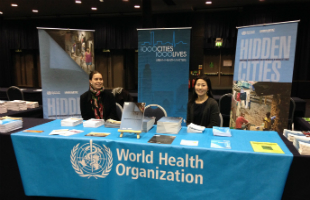
WHO Kobe Centre financial support for participants from developing countries
WKC financially supported the participation of 20 participants from developing countries at the Conference through a contribution to the International Conference on Urban Health (ICUH) 2014.
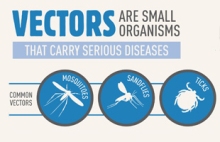
World Health Day 2014: Protect yourself from vector-borne diseases
On World Health Day, celebrated on 7 April every year, the World Health Organization draws attention to a public health problem of global proportions and what needs to be done to address it. The date of 7 April marks the anniversary of the founding of WHO in 1948.
The theme for World Health Day 2014 is vector-borne diseases.
More than half the world’s population is at risk of these diseases, which include malaria, dengue, leishmaniasis and yellow fever. The poorest people in the world are the most affected. However, environmental change and the rapid and increased movement of people and goods around the world means that the risks are now much more widespread. The World Health Day 2014 campaign focuses on vectors, the diseases they cause and simple precautions we can all take to protect ourselves and our families.
What are vectors?
Vectors are small organisms such as mosquitoes, bugs, ticks, flies and freshwater snails, that carry disease from person to person and place to place.
Campaign Goal
The campaign aims to raise awareness about the threat posed by vectors and vector-borne diseases and to stimulate families and communities to take action to protect themselves.
Objectives
- Families living in areas where diseases are transmitted by vectors know how to protect themselves.
- Travellers know how to protect themselves from vectors and vector-borne diseases when travelling to countries where these pose a health threat.
- In countries where vector-borne diseases are a public health problem, ministries of health put in place measures to improve the protection of their populations.
- In countries where vector-borne diseases are an emerging threat, health authorities work with environmental and relevant authorities locally and in neighbouring countries to improve integrated surveillance of vectors and to take measures to prevent their spread and proliferation.
How public health stakeholders can tackle vector-borne diseases
Effective, long-term vector control and disease elimination calls for strong, well-funded national control programmes, comprehensive national and regional strategies, supported by close collaboration among partners in the global public health community. Sustainable programmes require technical guidelines that set out clear standard operating procedures, and are well managed with efficient logistics, monitoring and evaluation.
Integrated vector management
WHO promotes integrated vector management as the best approach to strengthen vector control in a way that it is compatible with national health systems. Key elements of integrated vector management include:
- evidence-based decision-making based on research
- robust methods of monitoring and evaluation
- close collaboration between the health sector and other government sectors, as well as the private sector
- optimal use of human and financial resources through a multi-disease control approach
- use of a range of interventions, often in combination and synergistically
- planning and decision-making delegated to the lowest possible administrative level
- advocacy and social mobilization to promote vector control in relevant agencies, organizations and civil society
- a public health regulatory and legislative framework
- engagement with local communities to empower them and ensure sustainability of programmes
- increased capacity-building at national and local levels based on a situational analysis
For example, in view of the overlapping geographical distribution of malaria and lymphatic filariasis in large areas of Africa, Asia and the Americas, and the fact that Anopheles mosquitoes transmit both diseases, WHO recommends the use of integrated vector management in:
- areas co-endemic for malaria and lymphatic filariasis; and
- areas in which the vectors of the two diseases are affected by the same vector control interventions.
WHO also recommends integrated control of the Aedes mosquito vectors of dengue in some urban areas with control of Culex quinquefasciatus, an important urban vector of lymphatic filariasis.
WHO encourages…
Governments to
- commit at all levels (national, regional and local) to adopt and implement effective vector control policies.
- embed vector control in comprehensive disease control strategies.
- rationalize the use of resources and structures through integrated vector management.
- strengthen regulatory and legislative controls for vector control tools and methods.
Ministries of health
- improve surveillance and monitoring of vector-borne diseases.
- adopt a multi-disease approach i.e. integrate interventions to control and prevent vector-borne diseases with other disease interventions.
- develop and implement comprehensive insecticide resistance management strategies and ensure timely resistance monitoring.
- collaborate with other government sectors.
Ministries of the environment
- consider the impact on vectors for all development projects, including irrigation, hydroelectric dam construction, road building, forest clearance, housing development and industrial expansion.
- improve access to safe drinking-water and adequate sanitation to reduce contact with water infected with Schistoma parasite.
Ministries of education

- support awareness raising and behaviour change campaigns.
- develop school-based curricula, actively encouraging teachers to focus on environmental hygiene and management to prevent vector-borne diseases. for health and environment with a focus on controlling vectors and vector-borne diseases. Students can serve as peer-educators and health “ambassadors” in their families and neighbourhoods.
Ministries of finance, planning and overseas development
- recognize vector control as a national development issue.
- integrate funding for vector control into disease control budgets.
WHO encourages…
Local authorities
- provide a critical link in translating national vector control policies into practice at the local level.
- work in close partnership with communities.
Environmental, neighbourhood and other community groups
- create strong partnerships with government to tackle together the social and environmental determinants of health.
- engage in awareness raising activities.
- call for improved sanitation and protection of water sources.
- organize vector control activities such as vegetation and rubbish clearance.
- improve capacity of community members, community health workers and agricultural extension workers through practical training short courses on vector biology, ecology and control methods.
Private sector and donors
- Donors and the private sector should work together to enhance collaboration and coordination of activities to sustainably support control programmes efficiently and effectively.
- Provide incentives for the research and development of insecticides, next generation vector control tools, innovative medicines and diagnostic tools.
- Initiatives should be well-coordinated with robust systems for monitoring, evaluation and reporting, as well as procedures for rapid identification and correction of problems.
- For many diseases such as Chagas disease, schistosomiasis and leishmaniasis, WHO has run control programmes using medicines donated or subsidized by the private sector.
Families and households
Individuals can make a significant contribution to vector control by:
- knowing which vectors carry disease in their local setting and when travelling.
- using proven vector-control tools at home, such as insecticide-treated bed nets, and protecting themselves against insect bites when travelling.
- cooperating with local authorities for such interventions as indoor residual spraying programmes.
- participating in community-based health education about reducing the risk of vector-borne diseases.
- taking part in environmental management campaigns. e.g. reducing standing water that could provide a breeding environment for mosquitoes around homes.
For more information:

WKC Forum report: Innovation for Healthy Ageing – Examples of current trends in research –
WHO Centre for Health Development (WHO Kobe Centre - WKC) held the first WKC Forum of the 2014 calendar year on one of its core programmatic themes: Innovations for Healthy Ageing. More than 70 participants were in attendance to learn about the latest research in three key areas of Japanese innovation for ageing populations, including academics and students, researchers, health practitioners, local government, industry, media, and private citizens of Hyogo prefecture. This WKC Forum followed the Global Forum on Innovations for Ageing Populations, held in Kobe in December 2013, and presented the opportunity to dive deeper into discussion on innovations in pharmaceuticals, robotics and e-health, and falls prevention.

Professor Zhi-wei Luo of Kobe University presented examples of some of the leading innovations in robotics that he and his colleagues have engineered for the health and independence of older adults. As individuals continue to live longer, ageing has begun to transform societies in profound ways. This includes relatively diminishing human and financial resources to support us as we age. The advances in robotics presented by Professor Luo have shown that these technologies can help to mitigate this problem. Professor Luo and his team developed human-like robotic nurses, capable of sensing and processing information about the patient as well as the strength and care needed to help a disabled older adult to sit up or move. They also developed machines that can adapt to human capability for training or for support. Robotics include robotic systems as well, including sensors that can feed back information about a patient’s health and mobility, and predict falls or other health events. Robotic systems also offer virtual reality environments that can both test and stimulate brain function.

Dr Teiji Takei, Director at the National Institute of Biomedical Innovation, led a lively panel discussion with the speakers, motivated by questions from the participants. The discussion primarily covered four main topics, including improving research design, increasing collaboration between innovators across sectors, applications of science and technology for health, and how the WHO can support innovation and ageing. However, collaboration was at the core of the discussion, even as the Forum concluded and the conversation moved into the hallways. The conversation moved from knowledge sharing, to problem solving, to partnership, and large agreement that these conversations, even across sectors, need to continue.

Presentations (Japanese)
- “Accessible innovations on pharmacological treatment and health management for older people”
Professor Kiyomi Sadamoto, Department of Clinical Pharmacy
Yokohama College of Pharmacy
- “Health engineering for aging using robotics”
Professor Zhiwei Luo, Department of Computational Science
Graduate School of System Informatics, Kobe University
- “Steps to ageing well – Home and community-based technologies for older adults”
Dr Hyuntae Park, Chief Investigator, Section of Motor Function Activation
Center for Gerontology and Social Science, National Center for Geriatrics and Gerontology
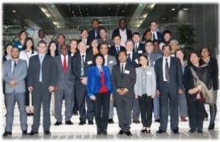
Expert review of Urban HEART
Over the past decade WHO Kobe Centre has supported city and national officials in their efforts to tackle health inequities. The Urban Health Equity Assessment and Response Tool (Urban HEART), since 2008, has provided a step-by-step guidance to local officials and communities to collectively analyse and act on inequities.
Urban HEART has been used in 50 cities from 35 countries by 2013. Users and experts have provided substantial feedback on how to improve the tool. Therefore, in November 2013, WHO Kobe Centre convened an expert meeting of academics, policy makers and international organizations in Kobe to deliberate on key areas of guidance in Urban HEART where users can be better supported.
Experts have provided specific advice to WHO on how to scale-up the use of Urban HEART and mainstream its use in city planning. The meeting report details the expert deliberations on revising Urban HEART.
2013
WKC Forum report: Suicide Prevention and Community Support
WHO Centre for Health Development (WHO Kobe Centre - WKC) organized a forum on “Suicide Prevention and Community Support” in Kobe, 19 December 2013. More than 40 participants came to the WKC forum from the general public, local governments and health workers to learn the current trends of suicide cases and deepen their knowledge on prevention and response efforts locally and globally.
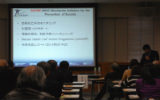
Dr Yutaro Setoya, Technical Officer of the Department of Mental Health and Substance Abuse (MSD), WHO HQ, reported about global trends and strategies for suicide prevention and presented on the WHO mhGAP Guideline. As concerns over the suicide prevention have grown globally, Member States agreed on a target of 10% reduction of the suicide rate in countries by the year 2020 at the 66th World Health Assembly in 2013. Dr Setoya announced that WHO will issue a first World Suicide Report in 2014. As Japan is advanced on the suicide prevention policy, further contribution from Japan to the global efforts for suicide prevention is expected, Dr Setoya said.
Dr Tadashi Takeshima, Director of the Centre for Suicide Prevention, Department of Mental Health Policy and Evaluation, National Institute of Mental Health, presented Japan’s fundamental policy on the comprehensive suicide prevention programme and emphasized that the key to reduce suicide is how the society as a whole can help people with suicidal thoughts to remove self-stigma. Statistically in Japan, suicide rates among the elderly have reduced while the rate among the youth has increased in recent years. Also, those who have attempted suicide and/or have harmed oneself are at the most risk of actually committing suicide, Dr Takeshima said. He also stressed that suicide prevention is a process to support them to retrieve their own freedom and the community as a whole need to support that process.
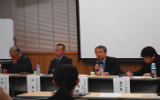
Mr Yasuo Hayashi, Director of the Suicide Prevention Section, Welfare Service for Persons with Disabilities Bureau, Health and Welfare Department of Hyogo Prefecture, presented the Hyogo Prefecture’s programme on suicide prevention. In Hyogo, suicide rates among people in their 20s and 40s haveincreased while the rates among people in their 50s and over 60 years old have decreased in recent years. From the local government perspective, Mr Hayashi presented Hyogo’s challenges to create “the society which no one will not be pushed to commit suicide”, such as implementing age-disaggregated projects for suicide prevention, strengthening the community system of watching over and early detection, and supports and cares for the bereaved.
As a representative of community support groups who provide free telephone counselling services, Mr Shigeaki Masaoka, Secretary General of Kobe Inochino Denwa, reported about their activities, suicide prevention efforts in Kobe City and their difficulty as a charity organization to balance their public relations activities for fundraising while protecting absolute privacy of consulters. Mr Masaoka reported that the number of telephone calls which Inochino Denwa receives annually is broadly flat since 2010, but more consulters hint their desire to commit suicide and/or confess their previous suicidal attempts during telephone counselling. He also expressed his deep concerns on the shortage of capable voluntary counsellors and the difficulty of their capacity building.

At the panel discussion and Q&A session, there were active discussions with the floor on actual suicide prevention and response projects on the ground, such as “Kobe G-P Net “(the comprehensive medical system to connect patients between Psychiatrists and General practitioners as team). Through discussions, it was shared among participants that there is still the need to deepen our understanding on suicide as a fact of attempting to kill oneself, to acknowledge repeating suicidal attempts as the highest risk factor of suicide, and to create more closer network among various actors at all levels in the society as a whole so as to reduce numbers of suicide cases.
Related links
- Presentation "Global Trends and Strategies for Suicide Prevention: WHO mhGAP Guideline" (Japanese)
Dr Yutaro Setoya, Technical Officer, Department of Mental Health and Substance Abuse (MSD), WHO HQ - Presentation "Suicide Prevention and Community Support" (Japanese)
Dr Tadashi Takeshima, Director, Centre for Suicide Prevention, Department of Mental Health Policy and Evaluation, National Institute of Mental Health - Presentation " Hyogo Prefecture's Suicide Prevention Programme" (Japanese)
Mr Yasuo Hayashi, Director, Suicide Prevention Section, Welfare Service for Persons with Disabilities Bureau, Health and Welfare Department of Hyogo Prefecture - Presentation "Activities of Inochino Denwa" (Japanese)
Mr Shigeaki Masaoka, Secretary General, Kobe Inochino Denwa
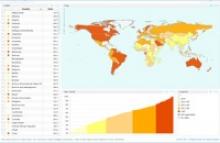
Request for Proposals: Developing a Guide for Urban Health Observatories
Since 2011, WKC has been conducting research and consultations on Urban Health Observatories (UHOs) as a potential institutional approach to improving the availability and use of local urban-level data for research, policy and practice to promote equity in health in urban settings.
Several milestones have been achieved so far. WKC organized an Expert Meeting on Urban Health Metrics in Kobe in February 2011, during which the experts recommended a comparative study of existing UHOs to identify good practices and to develop a guiding framework for UHOs. Subsequently, WKC undertook this research with the Belo Horizonte Observatory for Urban Health. The outcome of this research was recently published in the Journal of Urban Health.
In August 2012, WKC organized a Consultation Meeting on Local Urban Health Observatories in Amsterdam with an international group of scientific experts and representatives of international organizations and regional and local public health observatories. Based on the aforementioned research findings, the resulting UHO framework, and other inputs shared during the meeting, the expert group recommended that WHO continue with this work and develop a policy brief on the subject as well as a guide for UHOs. The experts identified several issues that would be important to address in a guide on establishing and sustaining UHOs; suggested a rough outline for the guide; and provided recommendations on the format and dissemination strategy for the guide.
Since then, the policy brief has been developed by WKC. Most recently, in September 2013, WKC organized a symposium at the International Conference on Urban Dynamics and Health in Paris, with current and former Directors of Urban Health Observatories in Barcelona, Belo Horizonte, London, and Strasbourg, respectively, as panellists. These panellists and other meeting participants expressed their support for the development of a WHO Guide for UHOs.
This Request for Proposals (RFP) seeks to identify a qualified professional (or team of professionals) to undertake the production of a guide for establishing, operating, and sustaining an Urban Health Observatory at a local government level, building upon the work that WKC and its collaborators have already achieved on this subject, and taking into consideration the recommendations and outputs from the consultation meeting in Amsterdam in 2012. The resulting Guide can be a valuable form of technical guidance which currently does not exist for WHO Member States and its constituents, especially at the local government level.
The deadline for submission is 10 November 2013.
Request for Proposals: Developing a Guide for Urban Health Observatories
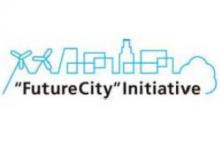
WKC at the 3rd International Forum on the “FutureCity” Initiative, Kitakyushu, Japan
The 3rd International Forum on the “FutureCity” Initiative was held in Kitakyushu on 19 October 2013, under the theme of “Creation of new value through integrating environmental, social and economic value.” The Forum was hosted by the Cabinet Secretariat and the Cabinet Office of the Japanese Government.
At the invitation of the Cabinet Office, WHO Kobe Centre (WKC) presented in the session dedicated to “Evaluation system of participatory governance toward self-sustained development”, and took part in a panel discussion with representatives from the Inter-American Development Bank, Malaysian Ministry of Housing and Local Government, and Keio University.
More information can be found on the website of the "FutureCity" initiative.
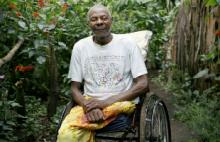
Advancing Technological Innovation for Ageing Populations in Asia
On this International Day of Older Persons (1 October), the WHO Kobe Center recognizes the contributions of older persons to our societies and reaffirms the UN Secretary-General Ban Ki-moon's call on countries and people to commit to remove barriers to older persons’ full participation in society while protecting their rights and dignity. With rapidly ageing populations in Japan and across the world, countries and communities are working to meet the needs and concerns of the world’s increasing number of older persons.
By 2050, the number of older persons will be twice the number of children in developed countries, and the number of older persons in developing countries is expected to double. This trend will have profound effects on countries and individuals. There is broad recognition that population ageing presents both a significant opportunity and a challenge.
As the UN Secretary-General stated in his message, the opportunity is to benefit from the many contributions older persons make to society. The challenge is to act on this understanding now through the adoption of policies that promote social inclusion and intergenerational solidarity. To tackle this challenge, innovative approaches and technologies are needed to promote greater quality of life, to reduce poor health, and to increase independence and productivity.
WKC is working to encourage greater technological and social innovation to assist ageing populations. In February 2013, WKC convened a unique Consultation with representatives from government, academia, industry and civil society on “Advancing Technological Innovation for Older Persons in Asia”. The conclusion of this meeting (highlighted in the report) identified the need for integrated approaches across government, industry, academia and civil society to encourage development of frugal innovations for medical and assistive devices, and to assure that they are available and affordable for growing ageing populations in an equitable manner.
Summary Report: Consultation on Advancing Technological Innovation for Older Persons in Asia

